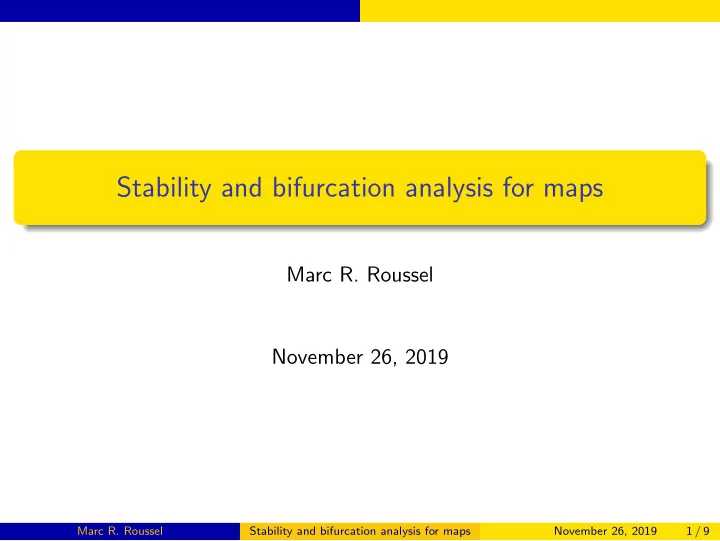

Stability and bifurcation analysis for maps Marc R. Roussel November 26, 2019 Marc R. Roussel Stability and bifurcation analysis for maps November 26, 2019 1 / 9
Fixed points Fixed points An equilibrium point is a point that doesn’t change under the action of the time evolution operator. Equilibrium points of maps are usually called fixed points. A fixed point of a map x n +1 = f ( x n , x n − 1 , x n − 2 , . . . ) satisfies x ∗ = f ( x ∗ , x ∗ , x ∗ , . . . ) Marc R. Roussel Stability and bifurcation analysis for maps November 26, 2019 2 / 9
Fixed points Example: fixed points of the logistic map Consider the logistic map x n +1 = λ x n (1 − x n ) The fixed points of this map satisfy x = λ x (1 − x ) ∴ x [1 − λ (1 − x )] = 0 x ∗ = 1 − 1 ∴ x † = 0 or λ Marc R. Roussel Stability and bifurcation analysis for maps November 26, 2019 3 / 9
Stability of fixed points Stability of fixed points Suppose x ∗ is a fixed point of the map x n +1 = f ( x n ). Consider a small perturbation from the fixed point such that x n = x ∗ + δ x n . Then x n +1 = f ( x n ) = f ( x ∗ + δ x n ) ≈ f ( x ∗ ) + f ′ ( x ∗ ) δ x n = x ∗ + f ′ ( x ∗ ) δ x n . But x n +1 = x ∗ + δ x n +1 . Comparing the two expressions for x n +1 , we get δ x n +1 ≈ f ′ ( x ∗ ) δ x n . Marc R. Roussel Stability and bifurcation analysis for maps November 26, 2019 4 / 9
Stability of fixed points Stability of fixed points (continued) So far: δ x n +1 ≈ f ′ ( x ∗ ) δ x n Theorem: A fixed point x ∗ of a map x n +1 = f ( x n ) is stable if | f ′ ( x ∗ ) | < 1, or unstable if | f ′ ( x ∗ ) | > 1. Marc R. Roussel Stability and bifurcation analysis for maps November 26, 2019 5 / 9
Stability of fixed points Stability of the fixed points of the logistic map f ( x ) = λ x (1 − x ) ∴ f ′ ( x ) = λ (1 − 2 x ) For x † = 0: f ′ (0) = λ . This fixed point is stable if λ < 1, and unstable if λ > 1. For x ∗ = 1 − 1 λ : f ′ ( x ∗ ) = λ 1 − 1 � � �� 1 − 2 = 2 − λ . λ This fixed point is stable if | 2 − λ | < 1. This is equivalent to − 1 < 2 − λ < 1, or 1 < λ < 3. Marc R. Roussel Stability and bifurcation analysis for maps November 26, 2019 6 / 9
Periodic orbits and their stability Periodic orbits A period- k periodic orbit is a sequence of iterates of the map such that x 1 → x 2 → x 3 → . . . x k → x 1 For a period-2 orbit, x 2 = f ( x 1 ), and x 1 = f ( x 2 ). It follows that x 1 = f ( x 2 ) = f ( f ( x 1 )). In other words, period-2 orbits are fixed points of the map x n +2 = f ( f ( x n )). In general, a period-k orbit is a fixed point of x n + k = f ( k ) ( x n ). The stability of periodic orbits can be studied by studying the stability of the map composed with itself k times. Marc R. Roussel Stability and bifurcation analysis for maps November 26, 2019 7 / 9
Periodic orbits and their stability Example: periodic orbits of the logistic map This is a good opportunity to use Maple. . . Marc R. Roussel Stability and bifurcation analysis for maps November 26, 2019 8 / 9
Periodic orbits and their stability Period-3 implies chaos If a map has a period-3 orbit, then it is a theorem that it must have orbits of all periods (Li and Yorke, 1975). Moreover, a period-three orbit implies that there exist points x 0 and y 0 such that applying the map starting from each of these points generates sequences in which the points pass arbitrarily close to each other, then move apart again, and later again pass arbitrarily close to each other, then move part, . . . at infinitum. These properties guarantee a chaotic trajectory, though not necessarily a chaotic attractor. However, in practice, you often (generally?) find a chaotic attractor “nearby” in parameter space if you find a period-3 orbit. Marc R. Roussel Stability and bifurcation analysis for maps November 26, 2019 9 / 9
Recommend
More recommend